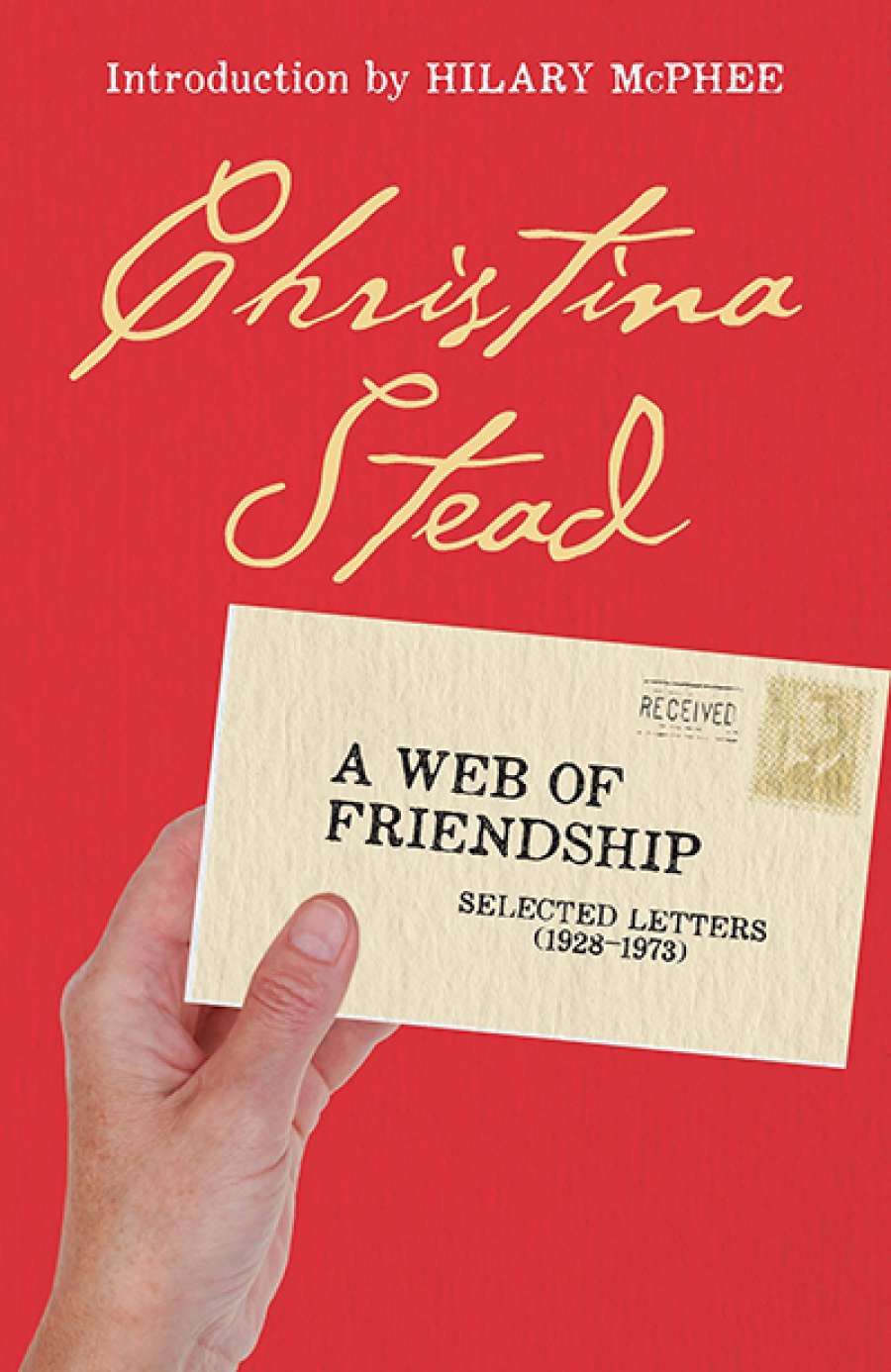
- Free Article: No
- Contents Category: Letters
- Custom Article Title: Graeme Powell reviews 'Christina Stead: A web of friendship, selected letters (1928–1973)' edited by Ron Geering
- Book 1 Title: Christina Stead
- Book 1 Subtitle: A web of friendship, selected letters (1928–1973)
- Book 1 Biblio: Miegunyah Press, $32.99 pb, 552 pp, 9780522862041
As Woolf implied, most letters necessarily have short lifespans. The bulk of Stead’s correspondence has probably not survived. Although she typed her letters, she seldom kept copies. Late in life, she destroyed many of her papers. In her early expatriate years, some of her Sydney relatives, as well as the writer Nettie Palmer, kept her letters. The American poets Stanley Burnshaw and Ettore Rella, whom she met after moving to New York in 1935, were both assiduous in preserving her letters over long periods. There are only scanty epistolary remains from the 1940s, the decade in which Stead wrote four novels, including The Man Who Loved Children (1940) and For Love Alone (1944). From 1950 onwards, however, the volume of surviving letters increases steadily and a few Australian correspondents appear, such as Walter Stone and Clem Christesen. By the 1960s the growing recognition of Stead as a major writer led to correspondence with more Australian writers, especially after she spent four months in Canberra in 1969. More than half the letters in A Web of Friendship were written in the ten years immediately preceding her return to Australia.
As a result of this unavoidable chronological imbalance, there is little or no record in the book of the process of writing most of the novels, apart from some retrospective comments. Cotter’s England (1967), one of her last books, is an exception, as Stead did sometimes write about her progress with the work and also the critical reactions that followed its publication. The most detailed accounts of her early novel writing can be found in her letters to Blake, especially during the 1940s, when they were often apart. They were omitted from A Web of Friendship, but were later published in Dearest Munx, the Letters of Christina Stead and William J. Blake, edited by Margaret Harris (2005).
 Christina Stead, 1938
Christina Stead, 1938
(National Library of Australia)In 1969 Stead said of Malcolm Lowry: ‘he was not a letter-writer; many good writers are poor at it: they put their real life into their writing’. Stead, in contrast, was a skilled letter-writer. Even when writing to people whom she hardly knew, she was generous with her time, she answered letters promptly and she responded in detail to their queries. In 1934 she wrote, ‘I have become a terrible talker, on paper’, and, as the years passed, her letters became more conversational. There were long paragraphs and numerous dashes, parentheses, and question marks. At various times she could be amusing, witty, acerbic, or self-deprecating. In her later years, she occasionally referred to loneliness, illnesses, and her grief following the death of Blake, but she quickly moved on to the lives and activities of her friends. Her letters were primarily concerned with people, places, and books, but she touched on many subjects: communism, finances, architecture, music, theatre, the ‘cultural cringe’, even a boxing match that she witnessed in Paris in 1931.
A Web of Friendship was the first of two volumes of letters originally published by Angus & Robertson in 1992. They were edited by Stead’s friend and literary executor Ron Geering, who played a major role in locating many of the letters and persuading the owners to place them in the National Library. The book has now been reissued by Miegunyah Press, with an introduction by Hilary McPhee, as well as the original preface by Geering. (Surprisingly, Geering’s name has been dropped from the title page.) In recent years, far more researchers have been writing about Stead than ever before, and many of them, as well as general readers, will be grateful that A Web of Friendship is again in print.
 Christina Stead
Christina Stead
(National Library of Australia)The work, however, has some obvious deficiencies when compared to other selections of letters, such as David Marr’s Patrick White: Letters (1994). Geering and McPhee give interesting assessments of Stead as a letter-writer, and the footnotes are useful in identifying the recipients of letters, some of whom were the models for characters in the novels. However, the footnotes are too succinct and there is too little contextual information, especially in relation to Stead’s American correspondents, who are hardly household names. Australian readers may need to turn to the biographies by Hazel Rowley and Chris Williams to make some sense of certain passages in these letters. The greatest weakness of the book is the lack of an index or even a list of the recipients. Consequently, only a close reading of the entire book will reveal Christina Stead’s views on Emily Dickinson, Jean-Paul Sartre, Mervyn Peake, Robert Lowell, Alexander Solzhenitsyn, or Patrick White, or her ideas on other writers and other subjects.


Comments powered by CComment